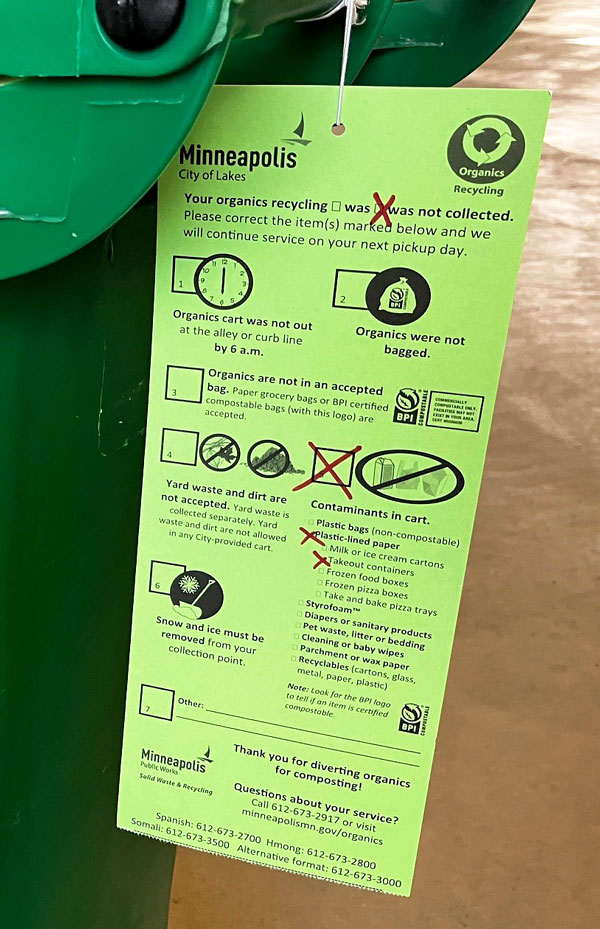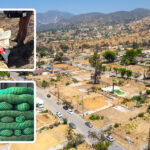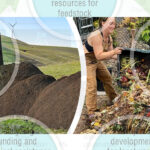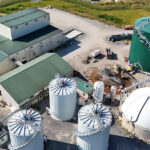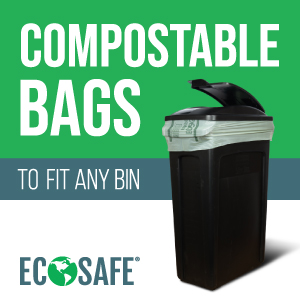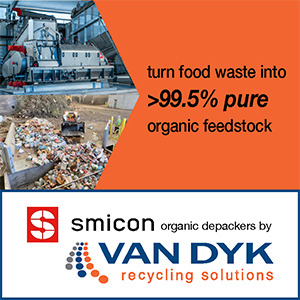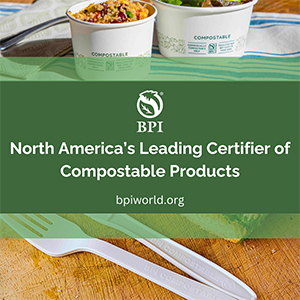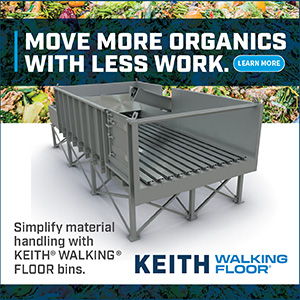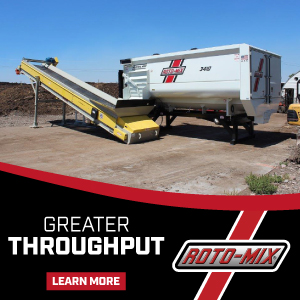Top: Back-of-truck hand sorts assess inedible vs. edible food in the organics cart, along with contamination in material collected. Photos courtesy City of Minneapolis Department of Solid Waste & Recycling
Nora Goldstein
Getting a handle on contamination in residential source separated organics — and how to mitigate it — is an ongoing challenge for food scraps collection programs. The City of Minneapolis, Minnesota, tackles that challenge head on through proactive steps at the curb. Both its curbside and drop-off services for food scraps collection accept all food scraps, food-soiled paper (including pizza boxes), and BPI-certified compostable products (plates, cups, bowls, takeout containers and utensils), houseplant trimmings and flowers, paper towels and tissues. The organics must be bagged for collection in brown paper bags or certified compostable bioplastic bags that carry the BPI logo.
The City’s collection crews have been trained to check carts each time before they are emptied. If contamination is found, the cart is not serviced, and an educational tag is attached to the cart. For households that continuously contaminate, the cart is taken away. The City describes this process of cart contamination monitoring as “crew intervention.” In 2024, a total of 1,760 carts were tagged, including 955 for contamination, 522 for yard trimmings in the organics cart (yard trimmings are collected separate from organics in Minneapolis), 239 for using the wrong bags, and 44 for putting food scraps in the cart unbagged.
“Our back-of-truck hand sorts evaluate material collected after crew intervention and have consistently found 1% or less contamination,” notes Kellie Kish, the City of Minneapolis’ Recycling Coordinator at the Department of Solid Waste & Recycling. “This results in a significant reduction in contamination going to the composting facility. By comparison, our 2022 Residential Waste Characterization & Capture Rate Study did not include crew intervention with the organics carts collected and found a contamination rate of 9.8%. Back-of-truck sorts — evaluating contents and tagging and not servicing contaminated carts — effectively reduces contamination almost 8%.”
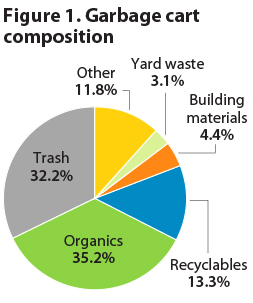 The 2022 study was conducted to obtain accurate data on quantities of recoverable commodities (recyclables and food scraps) in the trash, recycling and organics carts. A total of 700 random single-family homes were selected; 50% of the selected homes were signed up for food scraps collection and 55% had their carts out for collection. Contents of all the carts were sorted into 55 different categories; materials were weighed and recorded by cart type. Figure 1 captures the garbage cart contents (percent by weight). The “other” category includes textiles (7%), and scrap metal and electronics (3.6%). The sort found that 32.2% of what was in the trash cart belonged in the trash and 67.8% could be diverted. The organics cart contents had 50.6% food scraps and 23.5% wasted food (Figure 2).
The 2022 study was conducted to obtain accurate data on quantities of recoverable commodities (recyclables and food scraps) in the trash, recycling and organics carts. A total of 700 random single-family homes were selected; 50% of the selected homes were signed up for food scraps collection and 55% had their carts out for collection. Contents of all the carts were sorted into 55 different categories; materials were weighed and recorded by cart type. Figure 1 captures the garbage cart contents (percent by weight). The “other” category includes textiles (7%), and scrap metal and electronics (3.6%). The sort found that 32.2% of what was in the trash cart belonged in the trash and 67.8% could be diverted. The organics cart contents had 50.6% food scraps and 23.5% wasted food (Figure 2).
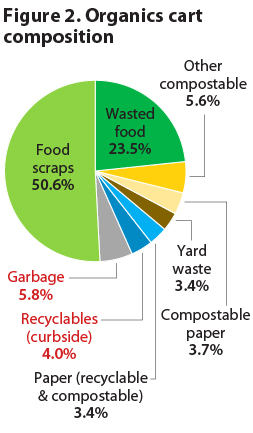 The findings also provided insight on a correlation between households opted in for organics collection: “Results from this 2022 Study indicate organics program subscribers have a much higher total average capture rate (including both recyclables and compostables) compared to non-subscribers,” according to the final study report. “Also, the recycling contamination is much lower in the subscribers’ group compared to non-subscribers.”
The findings also provided insight on a correlation between households opted in for organics collection: “Results from this 2022 Study indicate organics program subscribers have a much higher total average capture rate (including both recyclables and compostables) compared to non-subscribers,” according to the final study report. “Also, the recycling contamination is much lower in the subscribers’ group compared to non-subscribers.”
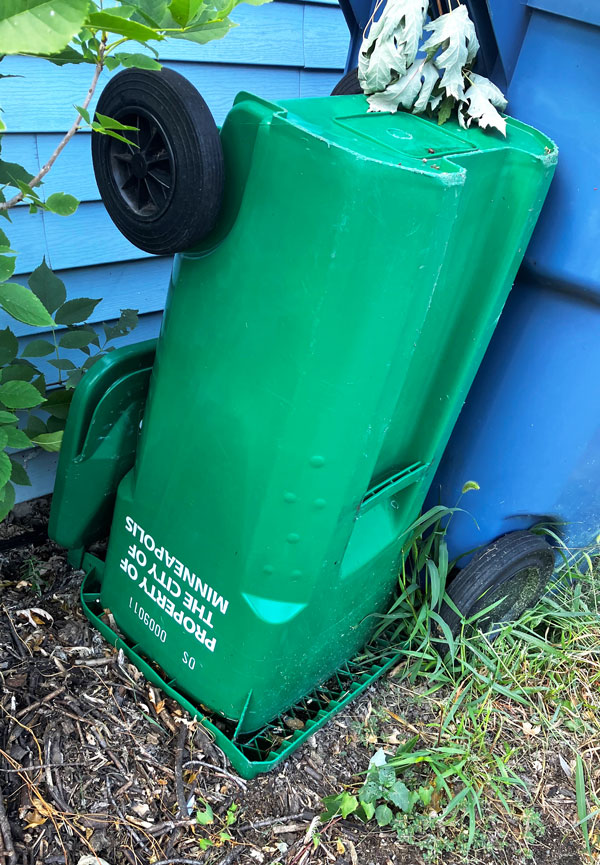
Last fall, collection crews flipped over unused organics carts. If the carts were still flipped over in December, they were picked up by the cart service.
The collection crews do not track the number of organics carts set-out while servicing the routes, so data on how many households participate each week is not available. Last fall, in efforts to remove unused organics carts from the field, collection crews flipped over unused organics carts. In December, if the carts were still flipped over, the crew wrote them up on a list and they were picked up by the cart service. A total of 785 carts were removed. Minnesota statute requires that jurisdictions with source separated collection of organics and recyclables send out an annual mailer to households about the service. “In general, we do see a spike in signups after our annual mailer goes out each year,” says Kish.
2024 Organics Load Sort
The City’s Solid Waste & Recycling staff has been conducting sorts of materials set out in the curbside organics program since 2017. The organics sorts are used to determine the most prevalent contaminants in materials set out, which in turn guides outreach and education. Volunteers tear open every bag and dump out the contents. Contaminants and food that could have been eaten are put into separate bins. Yard trimmings, although not considered contamination, are also set aside as those are collected separately from organics in the City’s program.
The most recent residential organics sort was conducted on October 30 and November 1, 2024. The last residential organics sort was in spring of 2021. Volunteers sorted through four truckloads of organics (11.08 tons) from preselected routes from around the city. Two routes have been sorted each year since the sorts began, and two new routes were selected. This was the first time sorts have been conducted in the fall but contents were not significantly different. Bags were ripped open and any contamination, edible food or packaging were separated from the rest of the pile and sorted into different sub‐categories.
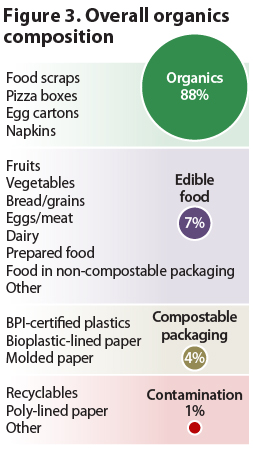 Sort categories were expanded upon from previous years to gather information on how much of a residential organics load was paper products, and on compostable product labeling, which is regulated in Minnesota. The major categories and sub‐sort categories are listed in Figure 3. Figure 4 captures the contents of each subcategory. “A lot more data was collected in 2024 than in the past as we really gave it our all to try and pull and weigh all paper products to evaluate what percent of a residential load was paper for the 2024 Minnesota Extended Producer Responsibility (EPR) law [the Packaging Waste and Cost Reduction Act] ,” explains Kish. “But we realized three hours in for two of the four truckload sorts that it was going to take far too long. And given how wet the paper products were, we weren’t entirely sure how the data would be used or if it would even be usable to calculate what portion of the organics stream should be eligible for reimbursement under the new EPR system.”
Sort categories were expanded upon from previous years to gather information on how much of a residential organics load was paper products, and on compostable product labeling, which is regulated in Minnesota. The major categories and sub‐sort categories are listed in Figure 3. Figure 4 captures the contents of each subcategory. “A lot more data was collected in 2024 than in the past as we really gave it our all to try and pull and weigh all paper products to evaluate what percent of a residential load was paper for the 2024 Minnesota Extended Producer Responsibility (EPR) law [the Packaging Waste and Cost Reduction Act] ,” explains Kish. “But we realized three hours in for two of the four truckload sorts that it was going to take far too long. And given how wet the paper products were, we weren’t entirely sure how the data would be used or if it would even be usable to calculate what portion of the organics stream should be eligible for reimbursement under the new EPR system.”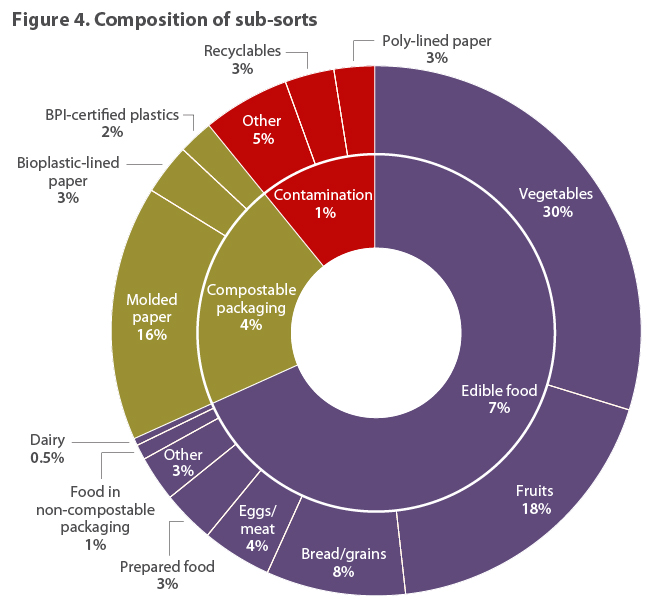
- Contamination: The contamination rate slightly increased since the Coronavirus pandemic when staff were not able to educate residents at neighborhood and community events as often as in the past years. The overall contamination rate for 2024 sorts was 1.10%. Plastic‐lined paper, as a single category, continues to be the number one contaminant by type found in organics recycling carts. Other contaminants included recyclables and non-compostable bags. Figure 5 shows the breakdown of contamination trends from 2017 to 2024.
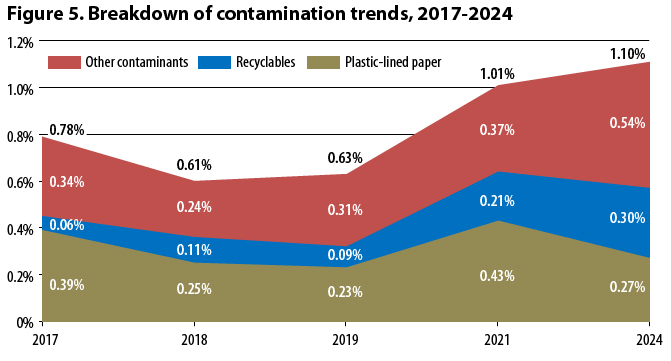
- Edible Food: The amount of edible food in each truckload ranged from 5.3% to 8.05%; the average was 7.1% or 447 lbs. The most common edible items identified were potatoes, oranges (including clementines), onions, carrots, limes, lemons and apples. Additional sorts were planned to determine if the amount of food wasted is higher in the fall than in the spring months.
- Compostable Packaging: The sorted loads contained 4% compostable packaging. Molded fiber foodservice ware represented the largest portion. The sort evaluated what percentage of each type of product that claimed to be compostable had a BPI certification logo on the product. (The Minneapolis program only accepts compostable packaging with the BPI logo.) For molded fiber foodservice packaging, 60% had the BPI logo and 40% was non-BPI compostable. The split for compostable plastics was 68% BPI-certified, and 32% non-BPI compostable. On January 1, 2025, Minnesota’s Compostable Product Labeling law, which was expanded beyond just bags to food service items and packaging, went into effect. The Minneapolis data from the 2024 organics sort creates a good baseline for tracking the law’s impact.



